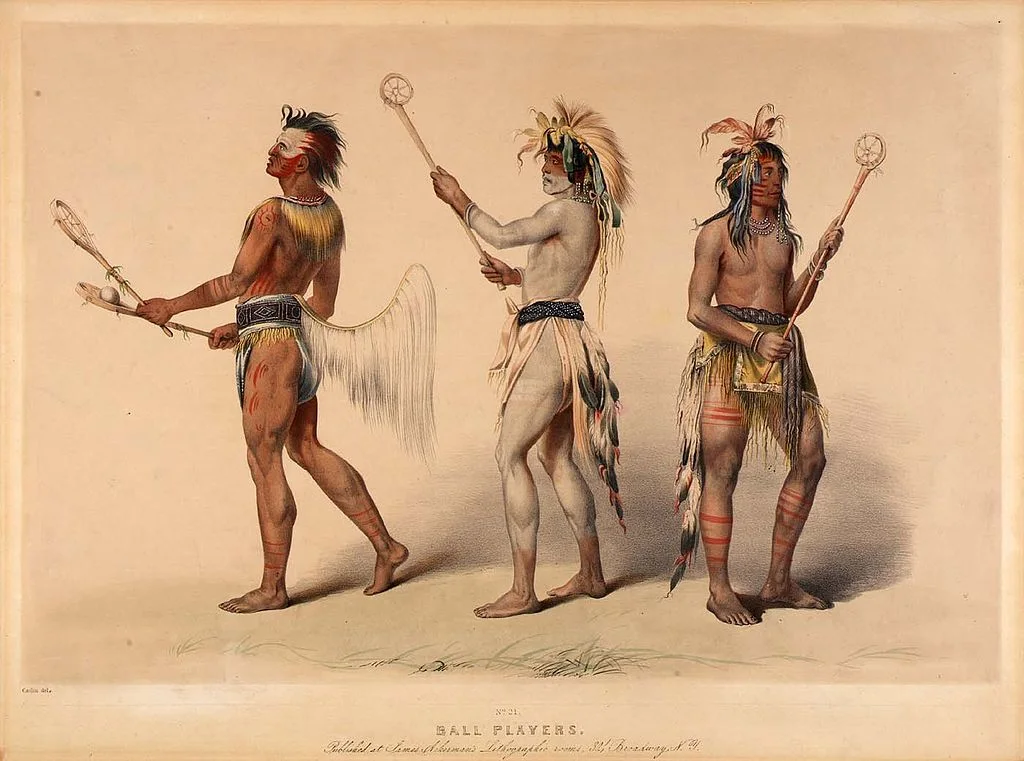
Play ball! Here are four games invented by Indigenous people
On National Indigenous Peoples Day, we take a look these ancient pastimes, some of which are still played today.
Indigenous people, from before Europeans' arrival in Canada all the way up to the present day, have had plenty of time to invent their own games of skill, depending on where they are.
Some are just to pass the time and test their skills in competition. Others served a more integral cultural purpose, almost a substitute for open warfare. Here are four which stood out.
Note: This story originally appeared in 2017 to coincide with that year's North American Indigenous Games.
LACROSSE

Indigenous lacrosse players. George Catlin/Wikimedia Commons.
We’ll start with one of the most prominent: The gruelling game we have come to call lacrosse.
The origins of the game, which today is played with a ball and hand-held nets, are murky, but it was widespread among many First Nations in eastern North America, and the current version may have originated among the Mohawk people. The Canadian Encyclopedia says it may also have had a ritual element to it in some stages.
Not a game for the physically unfit, early European missionaries report individual villages playing the sport against each other. It even played a role in at least one episode of First Nations resistance to European rule. According to some sources from Pontiac’s rebellion against the British in 1763, First Nations forces held a game outside Fort Michilimackinac, allowing their fighters to infiltrate the fort while its garrison was distracted.
It gained in popularity among non-Indigenous people, and when the National Lacrosse Association of Canada was formed in 1867, it was actually the first sports body in the dominion’s history, according to the Canadian Encyclopedia. It was named Canada’s official summer sport in 1994.
SHINNY

Boys in Sarnia Bay, Ont., picking teams for a hockey match. John Boyd/Wikimedia Commons.
There are few games more iconic of the North American winter than a group of children playing a few rounds of shinny on a frozen pond or river.
Though the concept of using a wooden stick to knock about a ball or puck of some kind seems to have originated in several locations around the world, it wasn’t a European import to North America. People here already had a version of shinny, played with curved sticks and a ball or bag usually made with buckskin. Its origins are unknown but it was relatively widespread by the 1500s, when European contact accelerated. Like hockey, it could be played on ice or on land.
The Smithsonian says it was especially popular among the Sauk, Foxes and Assiniboine peoples, though it was relatively widespread, and the rules varied from place to place.
Those three aforementioned peoples, for example, allowed men and women to play the game together, while other groups allowed all-men teams to play against all-women teams. As for the length of the field, Encyclopedia.com says the Miwok people of northern California played it on a two-hundred metre field, while the Navajo people of the U.S. southwest would play it over a range of more than a kilometre.
HOOP AND POLE
This game, whose rules and practices were greatly varied across much of North America, would have been particularly useful in hunter-gatherer societies who relied on a strong arm and good aim.
The most common elements to this particular game, known as 'chunkey' in some cases, were a pole, or spear, and some kind of rolling disc, made of anything from wood to stone. In some cases, the disc may be open, while in others, it may have had mesh or ropes spread across the opening.
The object of the game was also varied. In some reports, players had to try knock the disc or ring over completely as it rolled, while in others, it was enough for their spear or pole to land near the disc, and the winners were determined based on whose projectile landed the closest.
Aside from its obvious entertainment and training value, Archaeology Magazine says the mound-builder civilization that dominated the Mississippi area of North America long before European contact may have used the sport as a way to spread its influence, and bind the peoples of the region together.
MESOAMERICAN BALL GAME
Going by many names, the Mesoamerican ballgame is famous for a bit more than the discipline and coordination its players would have required.
As with the other games on this list, the details varied, but it was almost always played with a heavy rubber ball, with teams vying to knock it into a high stone hoop, often using nothing but their hips. And it was long-lived, coming to prominence among the Olmec people, the first known civilization of North America, and lasting through the ages to the Maya city states of Central America through to the Aztec Empire at the time of the Spanish conquest.
But as Atlas Obscura recounts, the point of the game gradually evolved from ritual and entertainment to something much crueller.
By the time of the Maya, the game was used as a stand-in for open warfare, with captured warriors forced to play it. The penalty for a loss would be death, with the losers sacrificed to the gods. That bloody practice was continued by the Aztecs, waning after that empire’s conquest by Spanish conquistadors. Normal versions of the game, without bloodshed, are still played in some parts of the region.
SOURCES: Canadian Encyclopedia | Smithsonian Institute | Encyclopedia.com | Archaeology Magazine | Atlas Obscura
